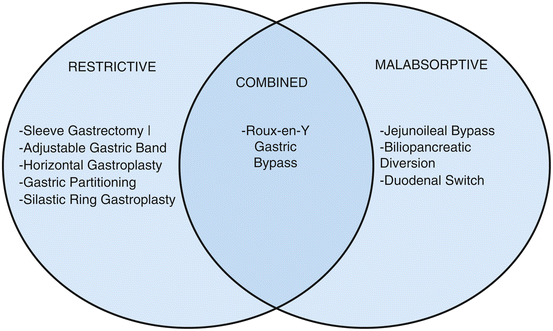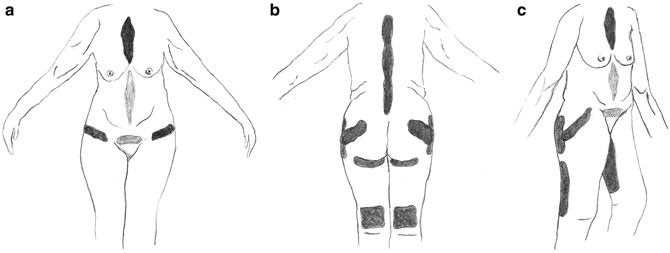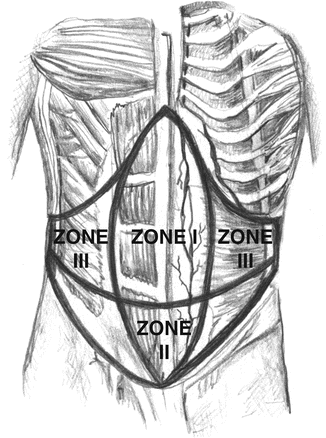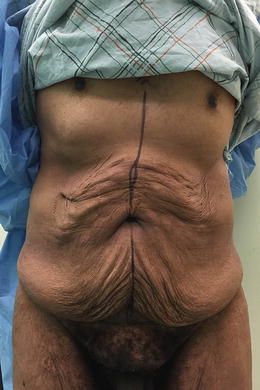Body mass index (BMI) kg/m2
Obesity classification obesity class
<18.5
Underweight
18.5–24.9
Normal weight
25.0–29.9
Overweight
30.0–34.9
Obesity Class I
35.0–39.9
Obesity Class II
≥40
Morbid/Extreme Obesity Class III
As obesity has become an epidemic leading to a decreased quality of life, the number of patients electing to undergo bariatric surgery has increased substantially. As a result, a new patient population has emerged: the massive weight loss patient. Massive weight loss (MWL) results in loss of soft-tissue volume with increased laxity, ptosis, and redundant skin. This is a population of patients presenting with diverse and severe contour deformities—different from those ever encountered previously by the plastic surgeon. As such, the demand for body contouring due to excessive skin after massive weight loss has dramatically increased, and will likely increase further.
The field of bariatric surgery has grown appreciably over the past decade, with multiple different procedures developed to induce weight loss and improve or eliminate obesity-related comorbidities. The National Institutes of Health states that surgery is the most effective therapy for long-term significant weight loss in morbidly obese patients [4]. Current guidelines recommend bariatric surgery in those with a body mass index of 40 kg/m2 or higher and for people with a BMI of higher than 35 kg/m2 who have significant comorbidities [5].
Several options for bariatric surgery exist including Roux-en-Y gastric bypass, sleeve gastrectomy, biliopancreatic diversion with or without duodenal switch and increasingly less common adjustable gastric band (Fig. 23.1). These procedures work through a combination of restriction, malabsorption, and hormonal changes to achieve weight loss. While most bariatric patients achieve good-to-excellent weight loss, one-third will achieve massive weight loss; each such patient will have unique combinations of nutritional and aesthetic implications with regard to reconstructive body contouring surgery.


Fig. 23.1
Bariatric surgical options
23.2 Impact of Bariatric Procedures
It is important to remember that nutritional deficiencies are common in the MWL patient. Bariatric procedures utilizing any degree of malabsorption can impair the body’s stores of critical vitamins and minerals that are vital for wound healing [6]. These include vitamins such as B12, iron, calcium, vitamins A and D, zinc, protein, and thiamine. Therefore, nutritional issues should be addressed with each patient preoperatively in order to optimize them for their body contouring procedures and recovery thereafter. Such body contouring procedures should only be considered at a time remote from the index procedure to allow the patient to regain a stable level of nutritional resources. Usually, this is a year or more following surgery.
Significant weight loss may have a large impact on skin’s elasticity. In obese patients, skin is under prolonged tension, with the resultant breakdown of many of the elastin fibers. When weight is lost, the excess skin remains, as the skin’s ability to retract back into place has been lost. MWL after bariatric surgery frequently results in redundant, amorphous and excess skin in most areas of the body, including the face, breasts, abdomen, arms, thighs, and buttocks. This can lead to rashes, infections, and musculoskeletal pain. Performing daily activities may become difficult and clothes may not fit properly, ultimately leading to embarrassment and further psychological issues.
Factors affecting skin elasticity can be broken down into two categories: those within the patient’s immediate control and those that are not. Aging and genetics, neither of which is controllable, play a large role in the skin’s cosmesis and appearance. Smoking, on the other hand, is a modifiable risk factor, which decreases arterial and capillary blood flow. Vessel constriction can lead to damage of connective tissues causing collagen breakdown at an accelerated rate as well as direct damage to skin fibroblasts (cells that form collagen and elastin). Diabetes mellitus can also contribute to loss of skin elasticity and tone due to dehydration and poor circulation as well as increased sensitivity to sun and UV light.
23.3 Preoperative Consultation
The preoperative evaluation is an important opportunity to address a variety of factors that are crucial in MWL patients. Body contouring surgery can produce results that improve both physical and psychological health, including greater exercise capabilities and physical tolerances which improve self-esteem and confidence. However, these operations are associated with high complication rates secondary to potential persistent obesity, nutritional deficiencies, weight-related comorbidities, and inelastic and poor quality tissue. Therefore, patient selection and practical considerations must not be overlooked.
When selecting patients to undergo postbariatric body contouring procedures, it is imperative to select individuals committed to leading a healthy lifestyle with dedication to proper nutrition and physical health. It is well known that the complications and risks in the postbariatric patients are indeed higher than that of the general population, making it critical that the surgeon spend adequate and ample time with the patients prior to their surgery in order to manage expectations.
For best results, the patient’s BMI should be less than 35 kg/m2, preferably less than 30 kg/m2, with a stable weight. Many people believe that there is no true BMI cutoff for body contouring surgery after MWL but rather a continuum, where increasing BMI correlates with increasing complications and suboptimal aesthetic results [7]. Since the patient’s height is a constant variable, the weight is the only manageable variable with regard to the BMI. Ideally, the patient should maintain a stable weight with fluctuations of no more than five pounds over a period of 3–6 months prior to elective procedures. Such a weight plateau is usually reached 12–18 months following bariatric surgery, depending on the type of bariatric surgery obtained. Patients who have undergone Roux-en-Y gastric bypass or sleeve gastrectomy tend to lose weight more quickly than those who have had an adjustable gastric band placed. Band patients may take up to several years to reach their lowest weight. Superior outcomes are achieved in those who are closer to their ideal body weight and are able to maintain a stable weight.
Each patient requires an individualized nutrition plan, tailored to the physiologic impact of their bariatric operation and their overall physical health. Since micronutrient and occasionally macronutrient deficiencies exist in the MWL patient population, a preoperative laboratory workup should be initiated several weeks to months prior to body contouring surgery, allowing ample time to correct any deficiencies that may be present (Table 23.2) [8]. Although patients may appear to be at a stable weight, this does not equate to a healthy weight. Vitamin and mineral deficiencies are often still present. Patients and surgeons must be made aware that overall nutritional optimization is essential for the best aesthetic outcome and uncomplicated recovery.
Table 23.2
Preoperative labs and studies for the massive weight loss patient
Preoperative labsa | Preoperative imaging/studies |
|---|---|
Complete blood count | Chest radiograph |
Coagulation studies (pt/INR/ptt) | EKG |
Comprehensive metabolic panel | CT Abdomenb |
Nutrition markers: Albumin Pre-albumin Micronutrients Iron Folate Vitamin B1 Vitamin B12 Calcium Vitamin D |
Managing comorbidities such as diabetes and cardiovascular disease is of paramount importance in this patient population. Additionally, smoking cessation is critical since smokers incur wound infection rates as high as 12 %, compared to 2 % in nonsmokers [9]. In diabetic patients, several factors can negatively influence wound healing including blood glucose levels, poor circulation, and neuropathy. The surgeon should work closely with the patient’s primary care physician or endocrinologist as appropriate to achieve smoking cessation and optimize blood glucose control prior to any elective or major surgical procedure.
Because previous abdominal operation suggests the possibility of occult abdominal wall hernias, special attention should be paid to surgical scars. Any abdominal incisions should be palpated both supine and sitting or standing to best evaluate the presence of a hernia. For an abdominoplasty, supraumbilical scars such as a Kocher incision can present problems with the blood supply of the superior flap, difficult dissection in the scar area, and/or patient dissatisfaction with the scar still visible postoperatively [10].
A history of venous thromboembolism including deep vein thrombosis or pulmonary embolism is the greatest single risk factor for future venous thromboembolism, the most potentially lethal morbidity after body contouring surgery [11]. Other risk factors include hormonal therapy/contraceptives, history of cancer or other hypercoaguable state, large bone fractures and immobility. High-risk patients should be properly assessed, treated and cleared by specialized physicians prior to elective body contouring procedures.
Patients should have a realistic expectation about outcomes after body contouring procedures for MWL. These are not procedures for treating obesity. They are designed to remove the excess skin and subcutaneous tissue and smooth the remaining skin. In essence, patients are trading excess tissue for long incisions that may or may not heal as perfectly as they like. Important concepts to emphasize to patients prior to surgery are the presence of scars, the lack of effect on regions outside those being treated, the potential for recurrence of skin laxity, the magnitude of recovery, and the risk of wound healing complications, which may require further operations. Postoperative management is equally important. Many of these procedures are major procedures that may take months to recover from and years to produce final results. As with most things in life, these results do not come without hard work and dedication to one’s self and the surgical process.
Ultimately, the MWL patients are a unique group of individuals that present multiple challenges for medical and ancillary practitioners involved in their care. A multidisciplinary approach is essential in order to achieve the best and most sustainable outcomes. The composition of this team may vary, but often includes a psychiatrist, a dietician, an exercise physiologist, a bariatric surgeon, and a plastic surgeon. Lifelong follow-up and surveillance will be of utmost importance to ensure continued weight loss success and to achieve the best aesthetic outcomes with the highest degree of patient and surgeon satisfaction.
23.4 Preoperative Examination
The profile of a MWL patient is unique in that nearly every part of the body can be affected. The physical exam should follow a discussion of the issues regarding the medical and surgical history. Attention should be paid to previous surgeries and the resultant scars. The physician should focus on the skin to determine its overall tone, quality, laxity and redundancy. The location of adherent rolls/folds, lipodystrophy, and regional adiposity should also be evaluated. Some areas may be damp, erythematous, or ulcerated. This should be documented.
The most common area of concern is typically the abdomen due to its central location and affect on clothing. Features to consider include existing scars, striae, and hernias. Perhaps most important is the amount and direction of excess tissue. Nearly all patients have excess tissue in the vertical direction. This may be addressed with a traditional abdominoplasty. Patients with excess laxity in the horizontal direction, as well, may be better addressed with a fleur-de-lis abdominoplasty.
The extremities represent another area of concern. Excess tissue in the upper arm becomes a concern if the patient wears short sleeve shirts. Excess tissue over the medial thighs is more of a concern with ambulation. If lower extremity procedures are to be considered, a thorough vascular examination should be performed. Distal pulses, presence of varicosities, the quality of the lower extremity skin, and range of motion of the joints must all be examined. Other areas, such as the face, may have minimal functional impairments but significant psychological concerns.
The Pittsburgh Rating Scale relies on a point-based rating system for severity of deformities in the MWL patient by anatomic region [12] and correlates severity to the type of treatment necessary. An assessment of overall body composition with bio-impedance analysis may also be used. A thorough physical examination will better prepare the plastic surgeon to determine the optimal procedures appropriate for each patient.
23.5 Staging Procedures
As noted, MWL patients often present with multiple areas of concern. A complete series of body contouring procedures may require several operations and therefore several years to complete. In order to maximize patient satisfaction, it is essential to understand and determine the patient’s priorities. If reasonable, these areas can be focused on first.
Patients with a higher starting BMI are more likely to require a staged approach than those with a lower BMI. Although aggregate minor complication rates are higher than in single procedure cases, there is no significant increase in complications on a per-procedure basis [13]. Proper staging is essential, as each procedure may have an impact on adjacent areas of the body. In most cases, a period of at least 3 months is necessary between stages. A clear advantage of the staged approach is that it provides an opportunity to revise recurrent skin laxity or defects after previous procedures.
In appropriately selected patients, if the surgery can be completed in a safe and timely fashion, multiple body contouring procedures may be combined into a single stage. When selecting procedures to combine, those that result in opposing vectors of tension should be avoided (Table 23.3). Length of operating time, surgeon fatigue, and financial burden on the patient must be taken into account when deciding the best plan for each patient.
Table 23.3
Combination body contouring procedures
Safe/Favorable combination of procedures | Unfavorable combinations that require caution |
|---|---|
Abdominoplasty and liposuction | Lower body lift and upper body lift |
Abdominoplasty and breast enhancement | Lower body lift and vertical thigh lift |
Abdominoplasty and lower body lift | Upper body lift and brachioplasty |
Abdominoplasty and brachioplasty | |
Lower body lift and brachioplasty | |
Lower body lift and breast enhancement | |
Upper body lift and breast enhancement | |
Brachioplasty and breast enhancement | |
Brachioplasty and thigh lift | |
Breast enhancement and thigh lift |
23.6 Body Contouring Procedures
23.6.1 Abdominal Surgery
Abdominoplasty is one of the most commonly performed aesthetic surgical procedures. In 1899, Kelly was one of the first surgeons to attempt to correct excess abdominal skin and fat, describing an operation involving a mid-abdominal incision [14]. Over the past 100 years, abdominoplasty has evolved as new techniques and operations have been developed. With regard to excess skin of the abdomen, there are multiple approaches that can be taken. Factors to consider include zones of adherence (Fig. 23.2), prior scars, presence and size of pannus or mons pubis, laxity and flaccidity of skin above and below the umbilicus, flaring of ribs, diastasis of rectus muscles, and existing hernias. Large incisional, umbilical, or ventral hernias may require complex repair before performing an abdominoplasty for aesthetic improvement. After thorough examination, categorization of each patient according to his or her treatable soft tissue layers of skin, fat and muscle can be made and the proper abdominoplasty technique utilized.


Fig. 23.2
(a–c) Fascial zones of adherence in the massive weight loss patient
23.6.1.1 Traditional Abdominoplasty
Traditional abdominoplasty is appropriate for the patient with excess skin and fat above and below the umbilicus, periumbilical hooding or diastasis rectus. Abdominoplasty allows for full access to correct abdominal wall musculoaponeurotic laxity. When performing traditional abdominoplasty, vascular zones I to III must be taken into account (Fig. 23.3). This is especially important when upper abdominal scars are present. Zone 1 is almost always interrupted by flap elevation in abdominoplasty, leaving zone 3 as the only remaining blood supply. A traditional abdominoplasty typically includes a lower abdominal incision (usually spanning from one hip to the other, ~7 cm above vulvar commissure or penis), skin flap undermining from the symphysis pubis to the xiphoid process, midline musculoaponeurotic fascial plication, translocation of the umbilicus, and dermolipectomy of the lower half of the flap to remove excess skin and fat in a vertical vector [9]. In the traditional abdominoplasty, the superior resection margin is above the level of the umbilicus.


Fig. 23.3
Three Zones of blood supply to the abdomen. Zone I: deep superior and deep inferior epigastric arteries. Zone II: epigastric arcade, superficial external pudendal, superficial inferior epigastric and superficial circumflex iliac arteries. Zone III: lumbar, musculophrenic and lower intercostal arteries
23.6.1.2 Limited Abdominoplasty/Mini-abdominoplasty
This technique was first described by Wilkinson and Swartz in 1986 [15] and refined further in 1987 by Greminger [16]. Patients with limited skin and subcutaneous fat located predominantly below the umbilicus who do not have significant diastasis recti, are ideal candidates for a mini-abdominoplasty. This procedure is less invasive than its traditional counterpart, involving a smaller incision with a smaller area of abdominal wall exposed. Undermining and plication of the fascia is only done up to the level of the umbilicus. The surgeon may choose to “float the umbilicus” by releasing it at its base to allow for further undermining of the abdominoplasty flap. The umbilicus is subsequently pulled inferiorly to eliminate laxity in the upper abdomen. Disadvantages of the mini-abdominoplasty include a potentially low umbilical position and abnormal umbilical shape. Recovery is usually more rapid and compares to that of liposuction.
23.6.1.3 Fleur-de-lis Abdominoplasty
In the MWL patient, traditional abdominoplasty techniques often fail to correct the complex contour deformities. There is often excess skin and soft tissue in the vertical direction as well as the horizontal direction. To address this concern, an additional vertical scar is needed [9]. The fleur-de-lis abdominoplasty (Fig. 23.4) was first popularized by Dellon in 1985 [17]. This technique utilizes an inverted “T” incision in order to facilitate the removal of circumferential lower truncal excess. The end result leaves the patient with a midline incision, similar to that of an exploratory laparotomy, in addition to a traditional abdominoplasty scar. The vertical limb must extend to the level of the xiphoid to minimize residual laxity and protrusion of upper abdominal skin and soft tissue. The presence of a preexisting vertical scar should make one consider this approach if there is also significant horizontal laxity. Dissection and undermining should be limited to that which is required to perform central plication, as extensive undermining past the xiphoid process can compromise the blood supply of the flaps. It is critical that the surgeon acknowledge that the full amount of horizontal resection and the full amount of vertical resection may not be possible. Movement of the abdominal flaps in both vectors should be considered prior to final resection [9]. It is important to counsel patients undergoing this procedure about the increased complication rates, including wound-healing concerns at the confluence of the incisions. This technique, however, can help eliminate both horizontal and vertical excess when appropriate.









